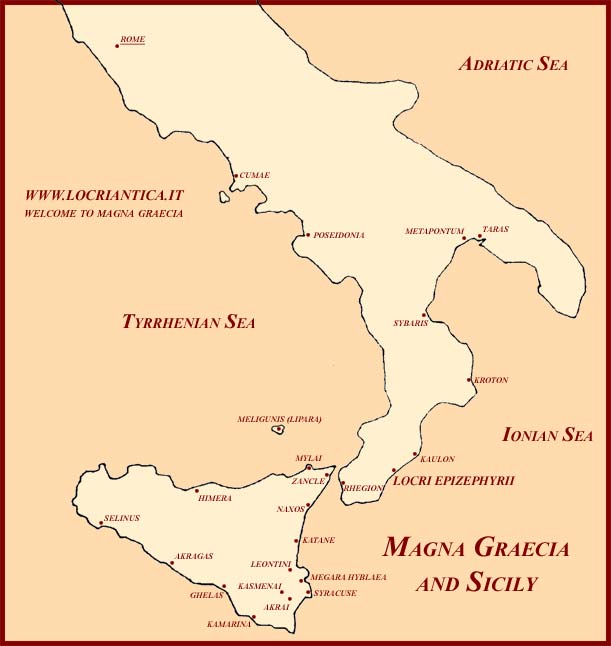|
The foundation date of the
colony of Locri
Epizephyrii is still a subject discussed
amongst the scholars; that is the result of some controversial
historical traditions which handed down three different
dates for such event: Eusebius, Caesarea's bishop (who
lived in the IV century a.D.) in the Armenian edition
of his work, tells us the year 673 b.C.; instead, Jerome
(who edited the Latin translation of Eusebius' work) dates
the foundation back to 679 b.C.; at last, Strabo,
without handing down a well-defined date, tells us that the
foundation happened shortly after the ones of Syracuse
(733 b.C.) and of Kroton (709 b.C.), therefore before the
end of the VIII century b.C. or in the beginning of the
VII century b.C.
Generally, the modern historians considered the 673 b.C.
date as the most trustworthy; on the contrary, nowadays,
thanks to new archaeological data, there is the tendency
to suppose an antecedent date, closer to Strabo's thesis.
|
|
|
|
FOUNDATION DATES OF THE MAJOR
CITIES OF MAGNA GRAECIA AND SICILY
|
|
|
THUCYDIDES |
EUSEBIUS OF CAESAREA |
JEROME |
OTHERS |
|
CUMAE |
-
|
-
|
1050(?)
|
-
|
|
METAPONTUM |
-
|
773(?)
|
-
|
-
|
|
ZANCLE |
-
|
757/756
|
-
|
756
|
|
NAXOS |
734
|
735
|
741
|
-
|
|
SYRACUSE |
733
|
733
|
738/737
|
733
|
|
LEONTINI |
728
|
-
|
-
|
-
|
|
KATANE |
728
|
733
|
737/736
|
-
|
|
MEGARA HYBLAEA |
727
|
-
|
-
|
-
|
|
RHEGION |
-
|
-
|
-
|
c. 730
|
|
MYLAI |
-
|
715(?)
|
716(?)
|
-
|
|
SYBARIS |
-
|
708-707
|
709-708
|
721/720
|
|
KROTON |
-
|
709
|
-
|
709/708
|
|
TARAS |
-
|
-
|
706
|
-
|
|
LOCRI
EPIZEPHYRII |
-
|
673
|
679
|
c. 700
|
|
POSEIDONIA |
-
|
-
|
-
|
700(?)
|
|
GHELAS |
688
|
688
|
691/690
|
-
|
|
KAULON |
-
|
-
|
-
|
c. 675
|
|
AKRAI |
663
|
-
|
-
|
-
|
|
KASMENAI |
643
|
-
|
-
|
-
|
|
SELINUS |
627
|
757(?)
|
650/649
|
650
|
|
HIMERA |
-
|
-
|
-
|
648
|
|
MELIGUNIS (LIPARA) |
-
|
627(?)
|
629(?)
|
580/576
|
|
KAMARINA |
598
|
598/597
|
601/600
|
598/596
|
|
AKRAGAS |
580
|
-
|
-
|
580/576
|
|
N.B.: More than
likely Zancle
was founded between the 730 and the 725 b.C. hence
Rhegion followed briefly;
Metapontum probably dates back to the 690 b.C.
and Poseidonia
was founded during the beginning of the VII century b.C.
Really higher dates in Eusebius of Caesarea's work
(and in Jerome's translation) are probably due to
the attempt of the ancient historical tradition of
establishing an uninterrupted relationship between
the oldest Greek settlements in western Europe and
the VIII-VII century b.C. colonial age; nowadays
this is something completely ruled out by the modern
historians. |
|
|
|
|
Instead, there are no doubts regarding the site where
the Greek settlers disembarked; it was cape Zephyrium (from
which the city took the name - see
Geographical Position
for more information),
nowadays cape Bruzzano, which the settlers left behind
after few years to move 25 km to the north where, solved
the "cohabitation" problems with the natives (Sicels),
they started the development of the new polis.
Another question still
opened regarding the colonization is which has to be
considered the place of origin of the Greek settlers.
As the same name of the polis suggests, the
settlers came from the Locris region, located in the
central Greece.
This is the certain datum; the problem
is that this region was split in three sub-regions:
the Ozolian Locris or western Locris, the Opuntian
Locris or eastern Locris and the Epicnemedian Locris.
On account that this last sub-region, the Epicnemedian,
in the Homeric tradition and in the tradition of the
ancient Greece was considered an integral part of the
Opuntian Locris (the region of the Ajax Oileus'
Locrians), the place of origin of the Greek settlers
has to be searched for in the Opuntian Locris or in
the Ozolian Locris.
Even the ancients
didn't agree upon the origin of the settlers;
particularly Strabo, probably referring to an older
source (Antiochus), affirmed for certain that Locri
Epizephyrii was founded by Ozolian Locris' settlers
led out by Evanthes. On the contrary, other traditions,
such as Ephorus' one, affirmed that the settlers came
from the Opuntian Locris.
More or less, both opinions have their strength;
and these opinions often base themselves on bound to
another unsolved question regarding the Locrian settlers:
their social class origins.
|
|
|

THE MAJOR CITIES OF MAGNA GRAECIA AND SICILY |
|
|
|
The traditions are controversial either upon this matter,
and they are essentially two: the former is the
semi-servile one, with Aristotelian origin, confirmed
by Polybius (Histories XII, 5-10) which claims
that the Locrians settlers descend from the union of
servants with their mistresses; the latter is the Timaeus' noble one, which denied the Aristotelian
thesis, seen only as an Athenian will to discredit
Locri allied with the rival Sparta, claiming that, on
the contrary, Locrians' origins were noble because
they were direct descendants of the "one-hundred
houses", the noblest one-hundred families of
Greece's Locris.
The Scholars' tendency, without considering the question
solved yet, is to believe that settlers' origin region
was the Opuntian Locris, without ruling out a limited
participation of settlers from Ozolian Locris, and
that in the settlers' origin have to be found,
doubtless, servile characters. |
|
|
|

